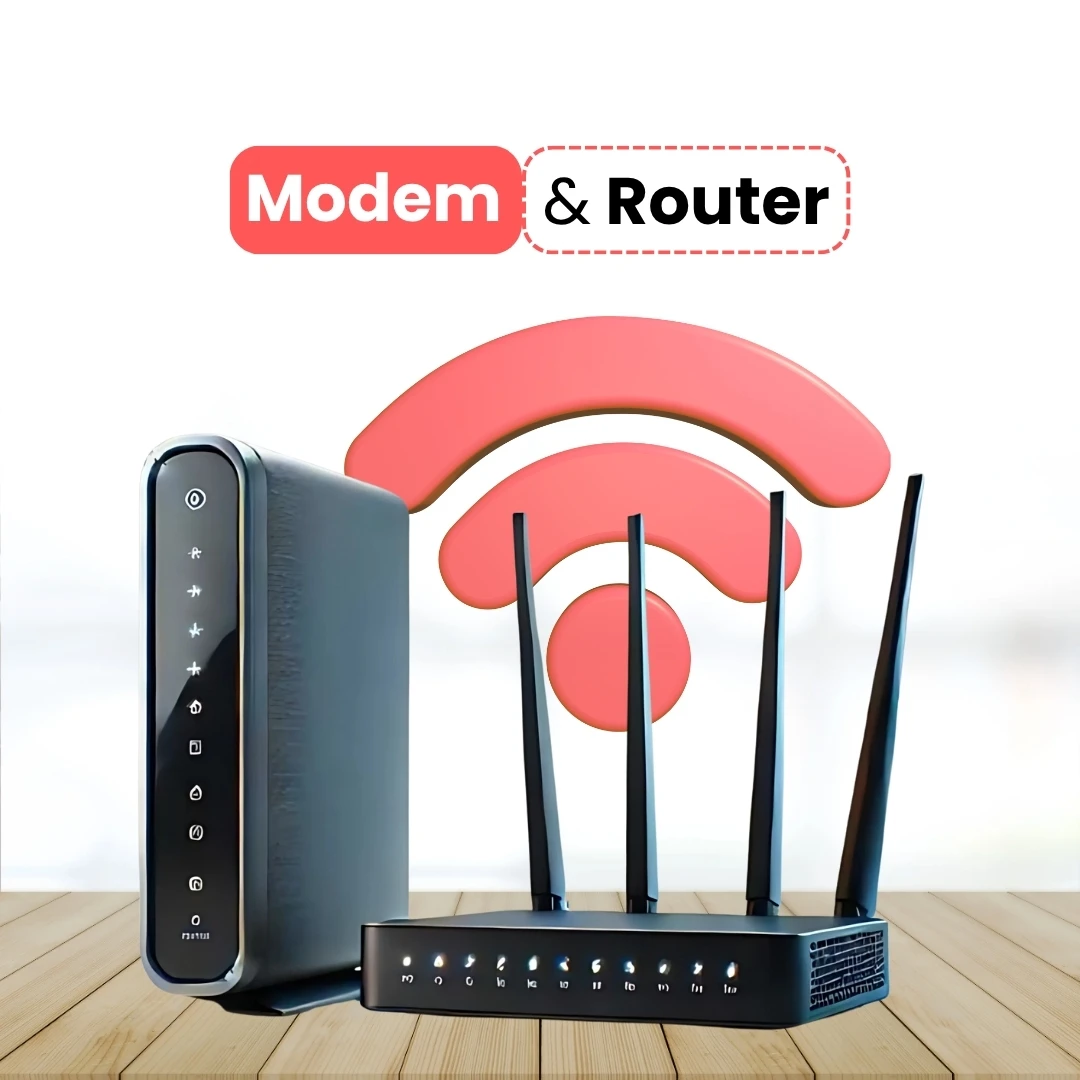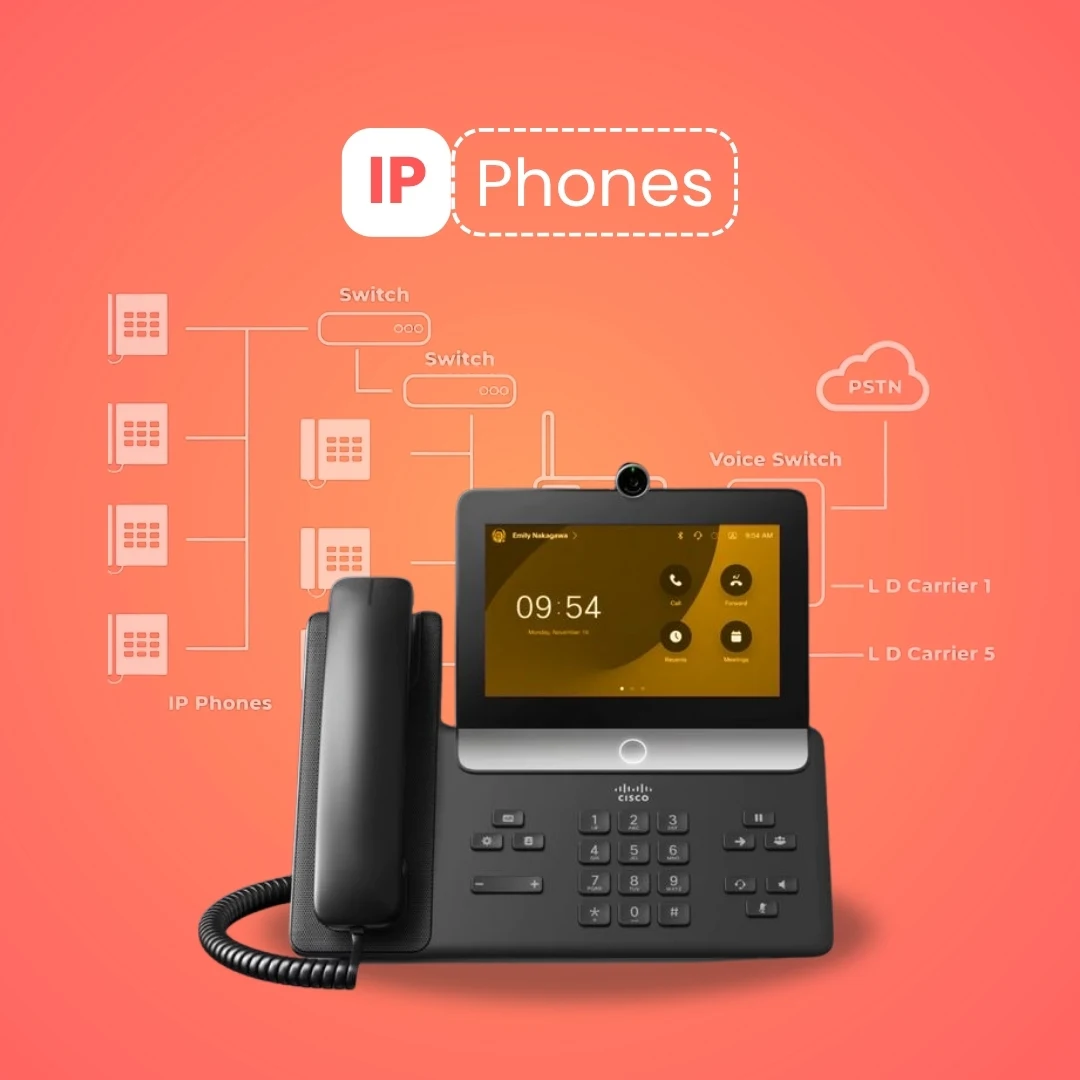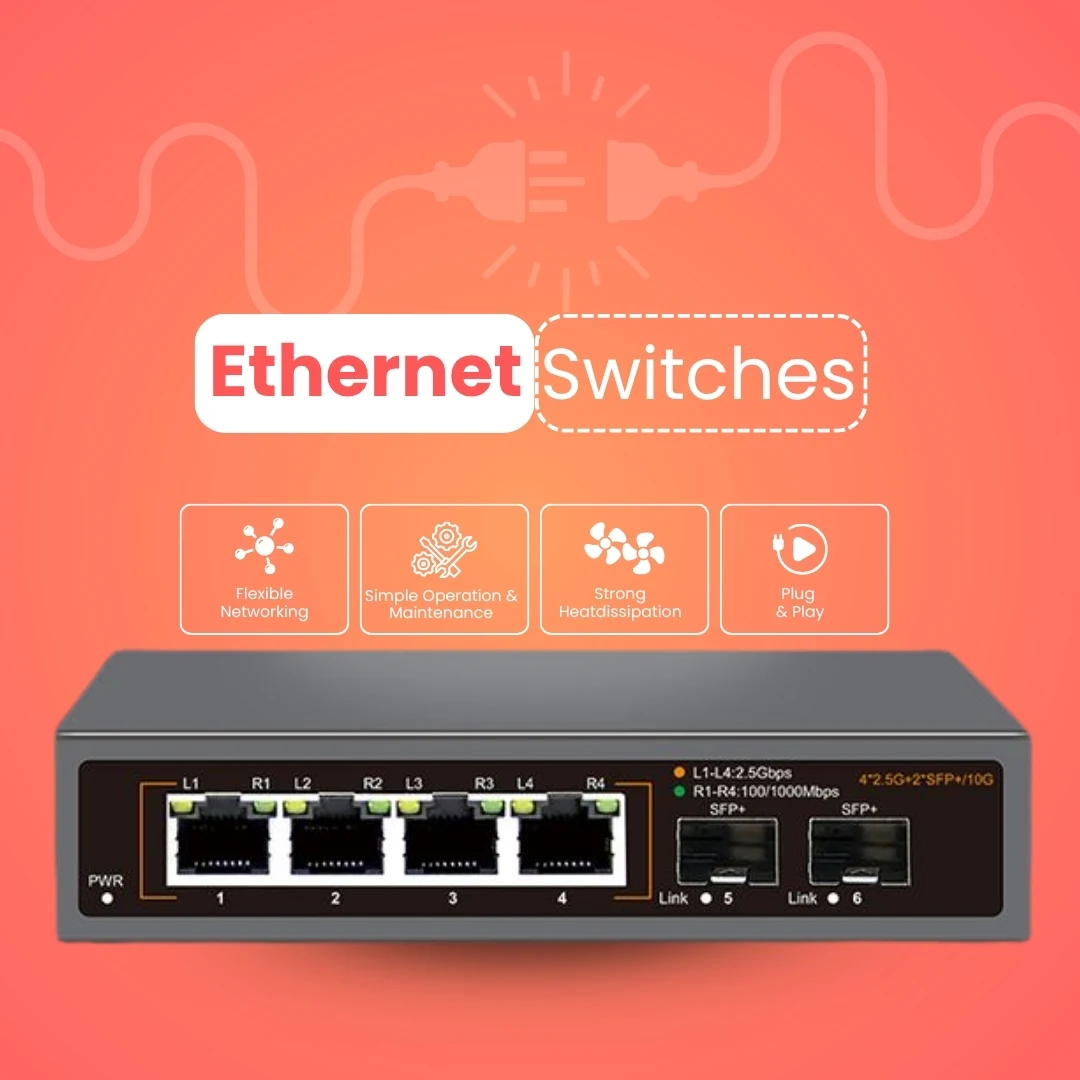Businesses implementing new VoIP systems or transitioning from legacy telephony must understand the function of each hardware component to build a stable, scalable, and high-performance communication infrastructure.
This guide helps IT professionals design and deploy such systems by explaining 11 essential VoIP hardware components—modems, routers, IP phones, VoIP gateways, Ethernet switches, analog telephone adapters (ATAs), softphones, Power over Ethernet (PoE) switches, headsets, media gateways, media servers, and uninterruptible power supplies (UPS).
Each component is evaluated by its function, deployment role, compatibility considerations, and impact on communication reliability. The article also defines selection criteria, compares hardware needs for cloud-based and on-premise deployments, and outlines operational risks tied to outdated or underperforming equipment. This structured overview supports informed, future-ready infrastructure planning.
1. Modem and Router

A modem (modulator-demodulator) converts digital signals from a computer or network into analog signals for transmission over a communication line. It also converts analog signals back into digital form. A router directs traffic between local devices and the internet. It assigns IP addresses and manages data packets to reach correct destinations.
In a VoIP setup, the modem establishes the internet connection as a bridge between the internal network and the Internet Service Provider (ISP). The router distributes the internet connection to all devices in the local network. These include IP phones, computers, and network-enabled hardware. A router with Quality of Service (QoS) capabilities assigns priority to voice traffic over other data streams, reducing latency during high network usage.
A modem and router combination provides consistent internet access essential for uninterrupted VoIP operations. The hardware supports communication across office-based and remote employees. QoS settings reduce packet loss during voice communication by prioritizing VoIP traffic. This includes setting bandwidth limits for non-voice applications and assigning higher priority to SIP and RTP protocols.
Modem compatibility with the Internet Service Provider (ISP) is essential. Routers that support Gigabit Ethernet and high-performance Wi-Fi improve local network speed and wireless connectivity. Firmware updates enhance device security and performance.
2. IP Phones

IP phones (Voice over Internet Protocol phones) are network-enabled devices that convert analog audio into digital packets for transmission over IP networks. Unlike analog phones using copper wires, IP phones support internet-based voice communication.
They connect via Ethernet to a router or switch and often support Power over Ethernet (PoE), enabling power and data delivery through a single cable. IP phones register with a VoIP server or cloud-based VoIP platform to handle call routing, features, and user authentication.
These devices serve as the main communication endpoints in business VoIP systems. Standard features include call forwarding, voicemail, conferencing, call transfer, and integration with business software such as CRM platforms. Their network-based design supports multi-location setups and remote operations.
Selecting an IP phone requires ensuring compatibility with the VoIP provider or PBX system. Key features to evaluate include HD voice, programmable keys, and display clarity. For high call volumes, headsets improve comfort and efficiency. Configuration involves entering network settings and SIP credentials, often automated via provisioning servers in large-scale deployments.
3. VoIP Gateways

VoIP gateways are hardware devices that convert analog voice signals to digital packets for IP transmission and vice versa. They bridge Public Switched Telephone Network (PSTN) systems with IP-based networks, enabling the integration of analog phones, fax machines, or PBX systems into VoIP infrastructure.
These gateways connect to both PSTN lines and the local IP network. They translate signaling protocols and media streams between analog and digital systems. Analog Telephone Adapters (ATAs) are basic VoIP gateways for connecting standard analog phones, while enterprise-grade gateways can link entire PBX systems to IP networks.
VoIP gateways allow phased migration to VoIP without replacing legacy hardware. They support cost reduction in long-distance communication and enable access to VoIP features. Gateways also connect branch offices with mixed telephony infrastructure
VoIP gateway selection depends on the number and type of analog interfaces required FXS ports connect analog phones; FXO ports connect to analog phone lines. Compatibility with the VoIP service provider or IP PBX is essential. Configuration involves setting network parameters, dialing plans, and codec support. Quality of Service (QoS) settings prioritize voice traffic to maintain call quality during signal conversion.
4. Ethernet Switches

Ethernet switches are network devices that connect multiple endpoints within a Local Area Network (LAN) and forward data packets only to the designated recipient. In VoIP environments, switches manage voice and data traffic between IP phones, computers, and other devices.
They serve as the backbone of the LAN, directing traffic based on MAC addresses. VoIP systems benefit from managed switches with Quality of Service (QoS) features that prioritize voice packets to reduce latency and jitter.
Switches support scalable VoIP deployment by connecting numerous IP phones and enabling reliable communication in high-traffic environments. Proper switch configuration improves call clarity and ensures stable network performance.
VoIP deployments require managed switches with QoS and, optionally, Power over Ethernet (PoE) to power IP phones via network cables. Switches should offer sufficient port density for current and future device needs. Configuration includes VLAN setup to separate voice and data traffic, along with QoS policy implementation to prioritize VoIP streams.
5. VoIP Adapters (ATA)
.webp)
Analog Telephone Adapters (ATAs) enable analog devices such as phones, fax machines, and conference phones to connect to Voice over Internet Protocol (VoIP) systems by converting analog voice signals into digital IP packets and vice versa.
ATAs typically include one or more FXS (Foreign Exchange Subscriber) ports for analog device connections and an Ethernet port for linking to a router or network switch. During a call, the ATA digitizes analog voice, encapsulates it into IP packets, and transmits it over the internet; the process reverses for incoming calls.
ATAs support businesses migrating to VoIP by integrating legacy equipment into IP-based networks. This avoids immediate replacement of analog endpoints and reduces hardware upgrade costs.
Selection criteria include compatibility with the VoIP provider and the required number of FXS ports. Configuration involves network setup, VoIP registration, and dialing plan programming. QoS support is essential for maintaining voice fidelity, particularly for fax transmissions requiring accurate timing.
6. Softphones
A softphone is a software application that enables voice calls over the internet using Voice over Internet Protocol (VoIP). It runs on devices such as computers, smartphones, or tablets and replicates desk phone functionality without requiring physical hardware.
Softphones integrate with cloud-based VoIP platforms or Unified Communications as a Service (UCaaS) systems, allowing users to access their business phone system from any internet-connected location. This flexibility supports remote work, mobility, and hardware cost reduction.
Standard softphone features include video calling, click-to-dial, call recording, visual voicemail, team messaging, and SMS. They allow users to maintain business numbers on personal devices while preserving privacy.
Most VoIP providers support softphones. Setup involves installing the application and configuring user credentials. While softphones work with built-in audio hardware, using a headset improves call quality and reduces background noise.
7. Power over Ethernet (PoE) Switches
Power over Ethernet (PoE) enables Ethernet cables to deliver both data and electrical power to devices over a single connection. A PoE switch provides power to PoE-enabled devices, such as IP phones, eliminating the need for separate power supplies.
PoE switches function as centralized power and data hubs within the local area network (LAN). A single Ethernet cable from the switch supplies both power and connectivity to each VoIP endpoint, reducing cabling complexity and installation costs.
PoE simplifies VoIP deployments in environments with many IP phones, including offices, call centers, and conference rooms. It reduces cable clutter, supports flexible device placement, and allows centralized power management, especially when used with an Uninterruptible Power Supply (UPS).
PoE switch selection should be based on the power requirements of connected devices and the switch's total power budget. PoE standards IEEE 802.3af, 802.3at (PoE+), and 802.3bt (PoE++) define maximum power per port. Most VoIP phones support 802.3af or 802.3at. Managed PoE switches provide QoS features to prioritize voice traffic and offer power scheduling and remote reboot capabilities.
8. Headsets and Microphones
Headsets and microphones enable audio input and output for VoIP communication. A VoIP headset integrates an earpiece and a built-in microphone for hands-free voice transmission and reception. These peripherals connect to IP phones, computers (for softphones), or mobile devices via USB, 3.5 mm jack, or Bluetooth.
They function as user-end devices that facilitate direct voice interaction in VoIP systems. Businesses with high voice communication demands such as call centers, support teams, and remote staff use headsets to improve productivity and call clarity. Noise-canceling features reduce ambient sound, ensuring professional audio during client and internal conversations.
Selection criteria include compatibility with VoIP phones or softphone applications, HD audio support, noise cancellation, and ergonomic design. Wireless models provide mobility, while wired headsets offer stable connections. Some headsets support plug-and-play use; others may require drivers for advanced functionality.
9. Media Gateways
Media gateways convert media streams and signaling protocols between traditional circuit-switched networks (e.g., Public Switched Telephone Network or PSTN) and packet-switched IP networks. In VoIP systems, they enable interoperability between legacy telephony infrastructure and modern IP-based communication by translating Time-Division Multiplexing (TDM) formats into Real-time Transport Protocol (RTP) packets and vice versa.
Deployed at the edge of IP networks, media gateways facilitate real-time conversion of voice, fax, and other media, allowing VoIP calls to originate from or terminate on traditional phone lines. They support integration with legacy PBX systems and analog devices, ensuring continuity for organizations transitioning to VoIP while maintaining connectivity with users on conventional telephony.
Media gateways are essential for enabling fax over IP and ensuring compatibility with existing telephony systems. Selection should be based on required interface types and quantities (e.g., T1/E1, FXS, FXO), codec support, and compatibility with VoIP platforms such as IP PBXs or softswitches. Configuration must include routing rules, dial plans, and Quality of Service (QoS) settings to ensure consistent media conversion and call quality.
10. Media Servers
A media server in a VoIP system processes and manages audio and video streams. It performs functions such as conferencing, transcoding between codecs, and supporting interactive voice response (IVR) applications. Media servers enable interoperability between diverse media formats across different networks and devices.
Integrated within the VoIP core, media servers operate alongside SIP servers. They receive Real-time Transport Protocol (RTP) streams from endpoints, process them, and route them to designated destinations. In call centers, media servers handle multi-party conferencing, call recording, and complex call flows.
They enable advanced communication features such as high-quality audio and video conferencing, supporting collaboration across distributed teams. In call centers, they power IVR systems for automated interaction and efficient routing, and support call recording for compliance, training, and quality assurance.
SIP servers control media servers using SIP messages that define stream processing instructions. Codec compatibility (e.g., G.711, G.729, Opus) ensures interoperability across VoIP endpoints and networks. Deployment considerations include processing capacity, scalability for concurrent streams, and compatibility with existing VoIP infrastructure. Both hardware and software-based media servers are available, offering flexibility based on organizational requirements.
11. Uninterruptible Power Supplies (UPS)
An Uninterruptible Power Supply (UPS) provides emergency power to connected equipment during power failures. In VoIP systems, it ensures continuous operation of modems, routers, switches, and IP phones during outages or voltage fluctuations.
Integrated into the VoIP power chain, a UPS acts as a buffer between the main power source and network hardware, supplying battery backup and surge protection. This allows VoIP systems to function temporarily during power loss, depending on UPS capacity.
UPS systems are critical for operations dependent on continuous VoIP communication, including call centers and emergency services. They prevent call drops, data loss, and downtime, supporting business continuity and customer service reliability. UPS units are especially important for powering PoE switches that supply electricity to IP phones.
Key selection factors include total equipment power consumption (in VA or Watts), required runtime, and UPS type (standby, line-interactive, or online). The UPS must have sufficient capacity to support all VoIP components for the intended duration. Many models also feature surge protection and automatic voltage regulation to protect sensitive hardware from electrical anomalies.
What should businesses consider when building a reliable VoIP hardware stack?
To build a reliable VoIP hardware stack, businesses must evaluate each component against defined technical and operational criteria. The table below outlines these evaluation factors in a concise, standards-compliant format.
.webp)
|
Key Evaluation Factors for VoIP Hardware Stack
|
|||
|---|---|---|---|
|
No. |
Factor |
Evaluation Criteria |
Purpose |
|
1. |
Network Compatibility |
The network must meet the minimum bandwidth, latency, and stability requirements for VoIP communication. |
This ensures consistent call quality and uninterrupted voice transmission. |
|
2. |
Scalability |
The hardware must support future increases in users and concurrent calls without requiring replacement. |
This prevents infrastructure overhauls during business growth. |
|
3. |
Hardware Lifespan |
VoIP devices must offer long mean time between failures (MTBF) and durable components. |
This minimizes downtime and reduces replacement frequency. |
|
4. |
Power Redundancy |
All critical devices must connect to an uninterruptible power supply (UPS) with sufficient backup duration. |
This maintains communication during power outages or voltage fluctuations. |
|
5. |
Capacity Planning |
Each component must support the expected number of users and peak call load with headroom. |
This avoids dropped calls and performance degradation. |
|
6. |
Security Capabilities |
Hardware must support encrypted transmission, firewalls, and intrusion prevention protocols. |
This protects communication from unauthorized access and data breaches. |
|
7. |
Quality of Service (QoS) |
Routers and switches must allow traffic prioritization through QoS settings. |
This reduces jitter, latency, and packet loss for voice traffic. |
|
8. |
System Integration |
The hardware must be compatible with business software such as CRM and ERP platforms. |
This enables centralized communication and operational efficiency. |
|
9. |
Usability and Management |
VoIP devices must include graphical user interfaces and remote configuration options. |
This simplifies deployment and reduces administrative effort. |
|
10. |
Vendor Support and Warranty |
Hardware must include access to vendor-level technical support and warranty protection. |
This ensures timely issue resolution and protects capital investment. |
How does hardware selection differ between cloud and on-premise VoIP systems?
VoIP hardware requirements vary significantly between cloud-based and on-premise deployment models. Cloud systems, also known as hosted VoIP, centralize infrastructure in the provider’s data center. This reduces on-site hardware needs to IP phones, a stable internet connection, and a business-grade router or switch. Complex components such as PBX systems, media servers, and VoIP gateways are managed externally. The cloud model offers lower upfront costs, simplified scalability, and minimal maintenance responsibilities, shifting the focus toward ensuring consistent connectivity and bandwidth.
In contrast, on-premise VoIP systems require businesses to install and manage all hardware internally. This includes an IP PBX, VoIP gateways, SIP trunks for PSTN connectivity, and backup power via UPS systems. High-performance switches with QoS capabilities are essential for internal traffic management. Although this model demands greater investment and ongoing IT oversight, it provides full control over configuration, customization, and system security.
The table below outlines key differences between cloud-based and on-premise VoIP solutions across core infrastructure, cost, scalability, and management responsibilities.
For hybrid setups, businesses combine elements of both cloud and on-premise solutions. This approach allows for a gradual migration to the cloud or leverages the strengths of both models. For example, a business might keep its existing on-premise PBX for internal calls while using cloud services for remote workers or specific applications. This requires careful planning to ensure seamless integration and interoperability between the two environments, often utilizing VoIP gateways to bridge the systems and ensuring consistent network quality across both setups.
.webp)
|
Hardware Requirements by VoIP Deployment Model
|
|||
|---|---|---|---|
|
No. |
Factor |
Cloud-Based VoIP System |
On-Premise VoIP System |
|
1. |
Hardware Location |
All infrastructure is hosted in the provider’s data center. |
All communication hardware is located and operated on the business premises. |
|
2. |
Core Hardware |
The system requires IP phones, a stable internet connection, and business-grade switches. |
The system requires an IP PBX, VoIP gateways, media servers, and SIP trunks. |
|
3. |
Initial Investment |
The setup involves low upfront cost due to provider-managed infrastructure. |
The deployment requires high capital investment in hardware and installation. |
|
4. |
Maintenance |
The provider performs all maintenance, upgrades, and system monitoring. |
The internal IT team manages all maintenance and hardware-related tasks. |
|
5. |
Scalability |
User capacity increases without hardware changes through provider-level configuration. |
System scaling requires additional hardware and manual configuration. |
|
6. |
Control and Customization |
Configuration options are limited and managed by the provider. |
Full control over routing, security, and feature implementation is available. |
|
7. |
Disaster Recovery |
Disaster recovery is handled by the service provider using off-site infrastructure. |
Backup power systems and failover mechanisms must be implemented on-site. |
What are the risks of using outdated or low-spec VoIP hardware?
Using outdated or low-specification VoIP hardware increases the risk of communication failures, security breaches, and system instability. These limitations affect operational efficiency, user experience, and long-term cost management.
- Degraded Call Quality
Legacy devices often fail to handle voice packet processing efficiently. This leads to jitter, packet loss, latency, and echo, which reduce voice clarity and interrupt communication. - Increased Security Exposure
Unsupported hardware may lack encryption, intrusion detection, and firmware updates. These vulnerabilities allow eavesdropping, toll fraud, denial-of-service attacks, and malware infiltration. - Reduced System Reliability
Aging components are prone to frequent malfunctions, crashes, and prolonged outages. These failures result in service disruption and reduced business continuity. - Limited Scalability and Feature Set
Older hardware often lacks support for advanced VoIP features such as video calling, CRM integration, or unified communications. These constraints prevent system expansion and technology adoption. - Higher Total Cost of Ownership
Frequent maintenance, energy inefficiency, service interruptions, and premature replacement increase the total cost over time. Security incidents may add significant financial and reputational loss.
Investing in modern VoIP hardware supports secure communication, improves call quality, and reduces operational risks across the organization.
Conclusion
Building a reliable VoIP hardware stack requires alignment between device capabilities, deployment models, and communication objectives. Each component—modems, routers, IP phones, gateways, switches, and power systems—must meet technical performance standards, support system compatibility, and allow for future scalability.
Cloud-based and on-premise VoIP systems define distinct hardware responsibilities, cost implications, and maintenance strategies. Outdated or underperforming hardware reduces reliability, increases security vulnerabilities, and degrades call quality. A structured planning approach improves communication uptime, simplifies system integration, and supports business continuity.
As VoIP technologies evolve, businesses must monitor advances in network protocols, AI-based call management, and unified communications platforms. Ongoing evaluation and timely hardware upgrades are essential for maintaining infrastructure resilience and supporting long-term performance.







